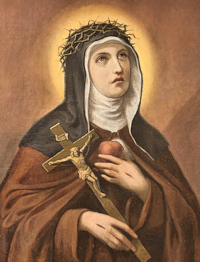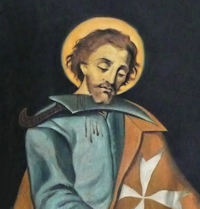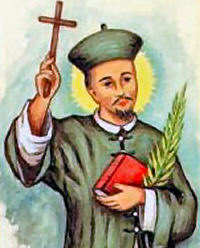Ordinary Time: July 9th
Optional Memorial of St. Augustine Zhao Rong, priest and companions, Chinese martyrs
Other Commemorations: St. Veronica Giuliani (RM); Bl. Adrian Fortescue (RM)
» Enjoy our Liturgical Seasons series of e-books!
Saint Augustine Zhao Rong was a Chinese diocesan priest who was martyred with his 119 companions in 1815. Among their number was an eighteen year old boy, Chi Zhuzi, who cried out to those who had just cut off his right arm and were preparing to flay him alive: "Every piece of my flesh, every drop of my blood will tell you that I am Christian." This optional memorial is new to the USA liturgical calendar and will be inscribed on July 9.
St. Augustine Zhao Rong and Companions
Christianity arrived in China by way of Syria in the 600s. Depending on China's relations with the outside world, Christianity over the centuries was free to grow or was forced to operate secretly.
The 120 martyrs in this group died between 1648 and 1930. Most of them (eighty-seven) were born in China and were children, parents, catechists or laborers, ranging from nine years of age to seventy-two. This group includes four Chinese diocesan priests.
The thirty-three foreign-born martyrs were mostly priests or women religious, especially from the Order of Preachers, the Paris Foreign Mission Society, the Friars Minor, Jesuits, Salesians and Franciscan Missionaries of Mary.
Augustine Zhao Rong was a Chinese soldier who accompanied Bishop John Gabriel Taurin Dufresse (Paris Foreign Mission Society) to his martyrdom in Beijing. Augustine was baptized and not long after was ordained as a diocesan priest. He was martyred in 1815.
Beatified in groups at various times, these 120 martyrs were canonized in Rome on October 1, 2000.
—Excerpted from Saint of the Day, Leonard Foley, O.F.M.
Highlights and Things to Do:
- Read more about the missionaries and Chinese believers who were canonized.
- Learn more about St. Augustine Zhao Rong and the other Chinese martyrs:
- Read the the canonization homily of St. John Paul II.
St. Veronica Giuliani
Ursula Giuliani was born of gentle folk of Mercatello in Urbino in 1660. When Ursula was four her mother took ill and on her deathbed, she consigned each of her children to one of the sacred wounds of Christ crucified. Veronica received Jesus' side pierced with a lance. Around this age, Ursula had a very irritable temperament, inclining to be very cranky and dictatorial.
 Ursula experienced at the age of seven her first mystical experience. "I remember that at the age of seven or eight years, Jesus appeared to me on two different occasions in Holy Week." It was from this time that Ursula practiced mortification freely and was attacked on many occasions by the Devil.
Ursula experienced at the age of seven her first mystical experience. "I remember that at the age of seven or eight years, Jesus appeared to me on two different occasions in Holy Week." It was from this time that Ursula practiced mortification freely and was attacked on many occasions by the Devil.
It was on July 17, 1677 that Ursula was admitted as a Capuchiness postulant. On October 28, she received the habit and the name Veronica. During her religious life, she was frequently plagued by Satan. He pushed her down stairs, appeared as her Novice Mistress, and beat her severely. To this, Jesus showed his peculiar favor by appearing to her in many forms and many times. At times, she would fall to the ground, so wrapped up was she in mystical contemplation.
Veronica held most offices in the Monastery during her life. She was Novice Mistress for twenty-two years. In 1716, she was appointed Abbess and remained so until her death. During her time as Abbess, Veronica proved herself, in practical matters, by building new dormitories on the Monastery and installing an elaborate water piping system.
The last thirty-five years of her life were those years when she became totally immersed in Christ. God willed that she undergo terrible aridity. Satan coupled to this, binding her in chains striking her and appearing as savage animals in her cell. It was at this time that Jesus transferred his crown of thorns to her head. This was to be completed later by the transfer of all His wounds.
Veronica underwent continuous scrutiny from doctors and examiners which added more to her constant agony. It was on July 9, 1727 that Veronica passed away. To her vow of obedience, she was so devoted that she required a ministerial permission to die. Her death was directly or indirectly due to the stroke which she suffered on June 6. She was canonized on May 26, 1839.
—Excerpted from the Capuchin Franciscans
Symbols and Representation: crowned with thorns and embracing the Cross; holding a heart marked with a cross
Patronage: diocese of Città di Castello, Italy
Highlights and Things to Do:
- Read more about St. Veronica Giuliani:
- Read Pope Benedict XVI's December 15, 2010, General Audience Address about St Veronica Giuliani.
- St. Veronica's body was initially incorrupt for a few years. It is located in the cloister of Capuchin Monastery of St. Veronica Giuliani.
Bl. Adrian Fortescue
 Bl. Adrian Fortescue was a Knight of St. John, martyr, b. about 1476, executed 10 July 1539. He belonged to the Salden branch of the great Devonshire family of Fortescue, and was a true country gentleman of the period, occasionally following the King in the wars with France (1513 and 1522), not infrequently attending the court, and at other times acting as justice of the peace or commissioner for subsidies.
Bl. Adrian Fortescue was a Knight of St. John, martyr, b. about 1476, executed 10 July 1539. He belonged to the Salden branch of the great Devonshire family of Fortescue, and was a true country gentleman of the period, occasionally following the King in the wars with France (1513 and 1522), not infrequently attending the court, and at other times acting as justice of the peace or commissioner for subsidies.
He was knighted in 1503 (Clermont; but D.N.B. gives 1528), attended the Field of the Cloth of Gold (1520), and late in life (1532) became a Knight of St. John. When Anne Boleyn became queen, Sir Adrian (whose mother, Alice Boleyn, was Anne's grand-aunt) naturally profited to some extent, but, as we see from his papers, not very much. The foundations of his worldly fortunes had been laid honorably at an earlier date. He was a serious thrifty man pains-taking in business, careful in accounts, and a lover of the homely wit of that day. He collected and signed several lists of proverbs and wise saws, which, though not very brilliant, are never offensive or coarse, always sane, and sometimes rise to a high moral or religious level.
All of a sudden this quiet, worthy gentleman was overwhelmed by some unexplained whim of the Tudor tyrant. On 29 August 1534, he was put under arrest, no one knows why, but released after some months. On 3 February 1539, he was arrested a second time and sent to the Tower. In April he was condemned untried by an act of attainder; in July he was beheaded. No specific act of treason was alleged against him, but only in general "sedition and refusing allegiance". The attainder, however, went on to decree death against Cardinal Pole and several others because they "adhered themselves to the Bishop of Rome". Catholic tradition was always held that Sir Adrian died for the same cause, and modern Protestant (Protestantism) critics have come to the same conclusion. His cultus has always flourished among the Knights of St. John, and he was beatified by Leo XIII in 1895.
—Excerpted from the Catholic Encyclopedia
Highlights and Things to Do:
- Read more about Bl. Adrian:
- Also see For the Honour of God, The Sacrifice of Bl. Adrian Fortescue






